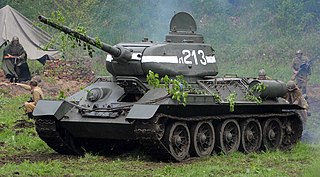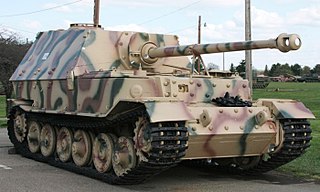
A tank destroyer, tank hunter or tank killer is a type of armoured fighting vehicle, predominantly intended for anti-tank duties. They are typically armed with a direct fire artillery gun, also known as a self-propelled anti-tank gun, or missile launcher, also called an anti-tank missile carrier. The vehicles are designed specifically to engage and destroy enemy tanks, often with limited operational capacities.

The T-34 is a Soviet medium tank from World War II. When introduced, its 76.2 mm (3 in) tank gun was more powerful than many of its contemporaries, and its 60-degree sloped armour provided good protection against anti-tank weapons. The T-34 had a profound effect on the conflict on the Eastern Front, and had a long-lasting impact on tank design. The tank was praised by multiple German generals when encountered during Operation Barbarossa, although its armour and armament were surpassed later in the war. Its main strength was its cost and production time, meaning that German panzer forces would often fight against Soviet tank forces several times their size. The T-34 is also a critical part of the mechanized divisions that form the backbone of the Deep Battle Strategy.

The Panzerkampfwagen IV, commonly known as the Panzer IV, is a German medium tank developed in the late 1930s and used extensively during the Second World War. Its ordnance inventory designation was Sd.Kfz. 161.

The SU-85 was a Soviet self-propelled gun used during World War II, based on the chassis of the T-34 medium tank. Earlier Soviet self-propelled guns were meant to serve as either assault guns, such as the SU-122, or as tank destroyers; the SU-85 fell into the latter category. As with the other AFVs in the SU series, the designation "85" refers to the vehicle's main armament, the 85 mm D-5T gun.

This article lists production figures for German armored fighting vehicles during the World War II era. Vehicles include tanks, self-propelled artillery, assault guns and tank destroyers.

The M3 Lee, officially Medium Tank, M3, was an American medium tank used during World War II. The turret was produced in two forms, one for US needs and one modified to British requirements to place the radio next to the commander. In British Commonwealth service, the tank was called by two names: tanks employing US-pattern turrets were called "Lee", named after Confederate general Robert E. Lee, while those with British-pattern turrets were known as "Grant", named after Union general Ulysses S. Grant.

The Panther tank, officially Panzerkampfwagen V Panther with ordnance inventory designation: Sd.Kfz. 171, is a German medium tank of World War II. It was used on the Eastern and Western Fronts from mid-1943 to the end of the war in May 1945.

Elefant was a heavy tank destroyer used by German Panzerjäger during World War II. Ninety-one units were built in 1943 under the name Ferdinand using VK 45.01 (P) tank hulls which had been produced for the Tiger I tank before the competing Henschel design had been selected.

The Tank, Infantry, Mk IV (A22) Churchill was a British infantry tank used in the Second World War, best known for its heavy armour, large longitudinal chassis with all-around tracks with multiple bogies, its ability to climb steep slopes, and its use as the basis of many specialist vehicles. It was one of the heaviest Allied tanks of the war.

The Jagdpanther, Sd.Kfz. 173, was a tank destroyer built by Germany during World War II. The Jagdpanther combined the 8.8 cm Pak 43 anti-tank gun, similar to the main gun of the Tiger II, with the armor and suspension of the Panther chassis.

The M18 Hellcat is a tank destroyer used by the United States Army in World War II and the Korean War. Despite being equipped with the same main gun as some variants of the much larger Sherman tank, the M18 attained a much higher top speed of up to 55 mph (89 km/h) by keeping armor to a minimum, and using the innovative Torqmatic automatic transmission.

The Royal Ordnance L7, officially designated Gun, 105 mm, Tank, L7, is the basic model of the United Kingdom's most successful tank gun. It is a 105 mm L/52 rifled design by the Royal Ordnance Factories, intended for use in armoured fighting vehicles, replacing the older QF 20-pounder (84 mm) gun mounted on the British Centurion tank. The successful L7 gun has been fitted on many armoured vehicles, including the Centurion, the German Leopard 1 and, in an altered design, as the M68 gun in several variants of the US M48 Patton and M60.

An armoured recovery vehicle (ARV) is typically a powerful tank or armoured personnel carrier (APC) chassis modified for use during combat for military vehicle recovery (towing) or repair of battle-damaged, stuck, and/or inoperable armoured fighting vehicles, such as tanks and armoured personnel carriers. Most ARVs have motorized tracks, like a tank or bulldozer, enabling the ARV to operate on uneven ground. The term "Armoured Repair and Recovery Vehicle" (ARRV) is also used.

The M4 Sherman tank was produced in several variants, a result of mass production spread across several manufacturers and several years. It was also the basis for a number of related vehicles and Shermans have been modified by several nations, ranging from upgrades to complete hull conversions for another task. Originally designed in 1941, M4 variants were still used by Israel during the 1967 and 1973 wars with its Arab neighbors.

The T-34 medium tank is one of the most-produced and longest-lived tanks of all time.

Tanks were an important weapons system in World War II. Although tanks in the inter-war years were the subject of widespread research, few were made, in just a few countries. However, during World War II, most armies employed tanks, and thousands were built every month. Tank usage, doctrine, and production varied widely among the combatant nations. By war's end, a consensus was forming on tank doctrine and design.

The Char D1 was an Interwar French light tank.

A light tank is a tank variant initially designed for rapid movements in and out of combat, to outmaneuver heavier tanks. It is smaller in size with thinner armor and a less powerful main gun, tailored for better tactical mobility and ease of transport and logistics. They are primarily employed in the screening, armored reconnaissance, skirmishing, artillery observation, and supplementing landing operations in a fire support role of expeditionary forces where larger, heavier tanks are unavailable or have difficulties operating safely or efficiently.

This article deals with the tanks serving in the German Army throughout history, such as the World War I tanks of the Imperial German Army, the interwar and World War II tanks of the Nazi German Wehrmacht, the Cold War tanks of the West German and East German Armies, all the way to the present day tanks of the Bundeswehr.

The Tiger I was a German heavy tank of World War II that began operational duty in 1942 in Africa and in the Soviet Union, usually in independent heavy tank battalions. It gave the German Army its first armoured fighting vehicle that mounted the 8.8 cm KwK 36 gun. 1,347 were built between August 1942 and August 1944. After August 1944, production of the Tiger I was phased out in favour of the Tiger II.





















